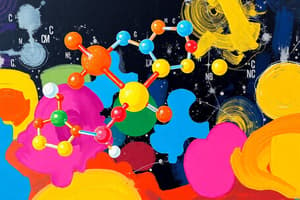Podcast
Questions and Answers
What is the general formula for monosaccharides?
What is the general formula for monosaccharides?
- (CH₂O)n, where n is greater than 7
- (CH₂O)n, where n is usually 3, 4, 5, 6, or 7 (correct)
- (C₆H₁₂O₆)n, where n is the number of carbon atoms
- (C₃H₆O₃)n, representing only pentoses
What are pentoses primarily known for?
What are pentoses primarily known for?
- They contain 5 carbon atoms. (correct)
- They are not soluble in water.
- They have 3 carbon atoms.
- They are primarily found in fruits.
Which statement accurately describes the chirality of monosaccharides?
Which statement accurately describes the chirality of monosaccharides?
- All monosaccharides are achiral.
- Monosaccharides do not have isomeric forms.
- Chirality is exclusive to disaccharides.
- Most monosaccharides are chiral and can exist as isomers. (correct)
What type of isomerism occurs between glucose and galactose?
What type of isomerism occurs between glucose and galactose?
Which characteristic is commonly found in monosaccharides?
Which characteristic is commonly found in monosaccharides?
What are the two forms that cyclic monosaccharides can take?
What are the two forms that cyclic monosaccharides can take?
Which monosaccharide is specifically a component of DNA?
Which monosaccharide is specifically a component of DNA?
Which functional group is abundant in monosaccharides and contributes to their solubility?
Which functional group is abundant in monosaccharides and contributes to their solubility?
What distinguishes diastereomers from enantiomers?
What distinguishes diastereomers from enantiomers?
What is a common sweet monosaccharide found in fruits and honey?
What is a common sweet monosaccharide found in fruits and honey?
Flashcards
Monosaccharides
Monosaccharides
Simplest carbohydrates; building blocks of more complex carbs.
General formula for Monosaccharides
General formula for Monosaccharides
(CH₂O)n, where n is usually 3-7.
Classification based on carbon atoms
Classification based on carbon atoms
Monosaccharides are classified by number of carbon atoms (triose, tetrose, pentose, hexose, heptose).
Pentose
Pentose
Signup and view all the flashcards
Hexose
Hexose
Signup and view all the flashcards
Stereoisomers
Stereoisomers
Signup and view all the flashcards
Enantiomers
Enantiomers
Signup and view all the flashcards
Epimers
Epimers
Signup and view all the flashcards
Glucose
Glucose
Signup and view all the flashcards
Hydroxyl groups (-OH)
Hydroxyl groups (-OH)
Signup and view all the flashcards
Study Notes
Monosaccharide Structure
- Monosaccharides are the simplest carbohydrates, also known as simple sugars.
- They are the fundamental building blocks of more complex carbohydrates like disaccharides and polysaccharides.
- They cannot be hydrolyzed into simpler sugars.
- The general formula for monosaccharides is (CH₂O)n, where n is usually 3, 4, 5, 6, or 7.
- The most common monosaccharides contain 5 or 6 carbon atoms.
Classification of Monosaccharides
- Monosaccharides are classified based on the number of carbon atoms in their structure and the position of the carbonyl group (aldehyde or ketone).
- Trioses: 3 carbon atoms
- Tetroses: 4 carbon atoms
- Pentoses: 5 carbon atoms (e.g., ribose, deoxyribose)
- Hexoses: 6 carbon atoms (e.g., glucose, fructose, galactose)
- Heptoses: 7 carbon atoms
Key Properties of Monosaccharides
- Sweet taste: Many monosaccharides have a characteristic sweet taste.
- Solubility: Monosaccharides are soluble in water due to their hydroxyl groups, making them readily dissolved in biological fluids.
- Crystalline structure: Many monosaccharides form crystalline structures under specific conditions.
- Chirality: Most monosaccharides are chiral, meaning they exist as isomers that are non-superimposable mirror images.
Isomerism in Monosaccharides
- Stereoisomerism: Monosaccharides with multiple chiral centers can exist as different stereoisomers, including enantiomers and diastereomers.
- Enantiomers are mirror images of each other.
- Diastereomers are stereoisomers that are not mirror images.
- Epimers: Epimers are a specific type of diastereomers that differ in the configuration of a single chiral carbon.
- Example: Glucose and galactose are C-4 epimers.
- Anomers: Monosaccharides can form cyclic structures (ring structures) by reacting with the carbonyl group with an alcohol group. The ring structure creates a new chiral center called an anomeric carbon. This results in alpha and beta anomers of the monosaccharide, which are different isomers.
Important Monosaccharides
- Glucose: A crucial energy source in nearly all living organisms.
- Fructose: Found in fruits and honey; known for its sweeter taste compared to glucose.
- Galactose: A component of lactose (milk sugar).
- Ribose: A component of RNA and other biomolecules.
- Deoxyribose: A component of DNA.
Functional Groups
- Hydroxyl groups (-OH): Abundant in monosaccharides, which contribute to their solubility and reactivity.
- Carbonyl groups (C=O): Present as aldehyde or ketone; crucial for ring formation and the identity of the monosaccharide.
Biological Roles
- Energy source: Primary source of energy for cellular processes.
- Structural component: Form part of larger carbohydrates (e.g., cellulose and starch), which contribute to the structure and function of plants and animals.
- Biosynthesis: Monosaccharides participate in the synthesis of various biomolecules (e.g., nucleotides, amino acids).
Studying That Suits You
Use AI to generate personalized quizzes and flashcards to suit your learning preferences.


